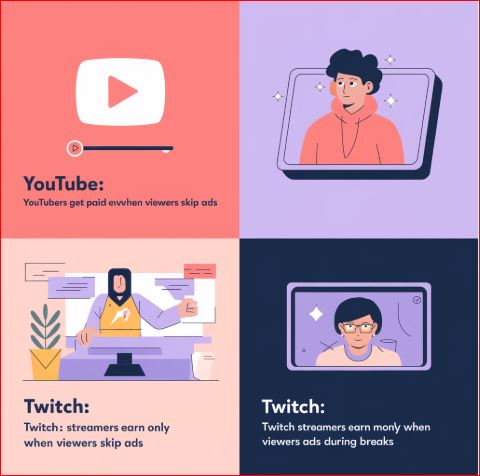YouTube vs Twitch Streaming
Over the last ten years, live streaming has taken over the internet game and the two largest content creator platforms, YouTube and Twitch, have risen to the top!
Whether you are a budding gamer, tech aficionado, musician, or someone looking to connect with an audience live, the platform you choose to publish on can either propel you to growth and success or to the opposite. Although YouTube and Twitch provide powerful tools for live streaming, their impact is different for creators and viewers.
Twitch is the king of gaming live streams, making interaction and community the core of the experience. In contrast, YouTube has an extremely broad user base and SEO advantages across multiple spaces beyond gaming.
Now that both are established platforms, they have their pros and cons and knowing what is what in terms of differences in the two may help you choose where to invest your time and efforts.
Whether you’re looking for content to monetize, grow a loyal audience, or maximize your reach, the war between YouTube and Twitch is less a matter of preference than one of strategy.
With each platform offering distinct advantages in terms of monetization options, discoverability, audience engagement, and technical features, this comparison will dissect the critical aspects you must ponder when determining if YouTube or Twitch is the ideal platform for your streaming odyssey.
So, let’s dig deeper!

YouTube vs. Twitch Monetization – Making Money Through Streaming
Monetization is an important aspect for many content creators hoping to build a career from streaming. Twitch and YouTube provide many revenue sources but are under varying models with their pros and cons.
Twitch’s main monetization sources are subscriptions, Bits, and ad revenues. The streamers also have an option of making money from the audience by giving paid subscription tiers with premium features like ad-free content and customized emotes.
Fans can buy Bits, which can be used to “cheer” on live streams, directly supporting the creators. Moreover, Twitch also shares ad revenue, but the potential to earn is usually not as high as with YouTube’s system.
One downside of Twitch is that streamers must work up to Affiliate status or a Partner level to make use of most monetization features in any meaningful way, and honestly, it takes a little time.
YouTube does offer ad monetization, Super Chats, channel memberships and revenue sharing for YouTube Premium. Since YouTube is intertwined with Google’s ad network, content creators generally make more from ads than they do from Twitch.
Super Chats are akin to Twitch Bits, letting users donate during live streams, and channel memberships offer exclusive perks, akin to Twitch subscriptions.
YouTube also enables on-demand content monetization, allowing creators to earn passive income from their previous streams; an option that is missing for creators on Twitch.
If you want ad revenue and long-term passive income on your videos, YouTube provides a more reliable model. If you prefer a platform that’s built around subscriptions and donations and relies on community support directly, Twitch might be the better fit.
Understanding Your Audience and Community Engagement
Audience engagement is the crux of a live stream and Twitch and YouTube provide unique features to help foster interaction and build a loyal community. However, the way people engage with the two platforms is different.
Twitch relies on interactivity, with real-time chat at the forefront. But the chat experience is rightly considered one of Twitch’s strongest aspects, with emotes, chat commands, and interactive extensions helping to liven up interaction.
Twitch streamers also create content driven by the audience through chat, where participation and requests shape the direction of the stream.
Twitch, in addition, offers Raiding and Hosting so that a creator can send their audience to another live channel, helping build a sense of community and collaboration amongst streamers.
YouTube also enables live chat, but it has a somewhat less passive watching experience. The platform is organized for both live and on-demand content, so audience interactions tend to be more extensive than the live stream they watch.
There are things streamers can do, such as comments, pinned messages, or community posts, which enable them to engage in an activity even after the reminder that the stream has ended. Super Chats and Memberships promote direct support, but the real-time chat culture isn’t baked into YouTube, as it is on Twitch.
If you’re all about real-time engagement and a super active chat, Twitch is where you want to be. Yet, if you are looking to open up new interactive narratives beyond the live feeds and develop a more immortalized following, the tools on offer are far better for community building on YouTube.
Discoverability: Which Platform Do You Grow Faster On?
Discoverability is one of the biggest struggles in audience building, especially for new content creators. Twitch and YouTube content discovery mechanics are worlds apart, which means you must know how both of them work if you want to grow strategically.
Twitch
Discoverability within Twitch is mostly based on the visibility of live content. As you’re live, you show up in a category (like a certain game or topic), and users who are browsing that category may just come upon your stream.
On the other hand, the lack of a recommendation algorithm on Twitch means new streamers struggle to garner eyeballs unless they come with their own audience or partnership with larger creators. Since Twitch focuses more on live content, streams have a lesser chance to drive views after they’ve ended and, therefore, have limited long-term discoverability.
YouTube
YouTube, by contrast, has one of the world’s most powerful recommendation algorithms. Because it favors live and pre-recorded content, streamers can optimize their videos for SEO with catchy titles and descriptions as well as attention-drawing thumbnails to open up to larger audiences.
Unlike other sites where once the live stream is over, it is no longer searchable, YouTube makes it so your content can be found and discovered for as long as it is in existence, which allows you to get views on your content long after it was live-streamed. Plus, YouTube Shorts and community posts offer other opportunities for engagement and attracting new viewers.
If you’re a streamer looking for instant visibility in live sessions, category-based browsing on Twitch can work well. But for those seeking sustained long-term growth, YouTube’s potent algorithm and content discovery tools provide a massive advantage.

Content Flexibility: Live Streams vs. On-Demand Videos
The type of content is one of the biggest differences between YouTube and Twitch. Twitch is designed for live content, so most streams are consumed live. It does allow streamers to save past broadcasts as VODs (Video on Demand), but those aren’t heavily promoted by Twitch’s algorithm and often vanish after a certain period of time unless manually saved as Highlights.
This means that Twitch’s content is short-lived, and streamers must go live frequently to be seen and engaged.
YouTube has live streaming, pre-recorded videos, Shorts, community posts, etc. Live-streams can readily be cut into highlight reels, full-length videos, or clips that keep the engagement going long after a stream is over.
This versatility means that creators don’t have to rely exclusively on being live to grow their channel, as evergreen content can engage new viewers continually.
If you like the fast-paced interaction of live streaming, and building an audience from that, Twitch is the better platform. However, if you will like the ability to produce content outside of live streams and the benefit of search algorithms working on your behalf for growth over time, there is a much wider surface area of opportunity with YouTube.
Subscription Models and Revenue Splits
While Twitch and YouTube have subscriptions (or memberships in YouTube’s case) that let viewers directly support their favorite streamers, both pay out differently when it comes to revenue splits.
Subscriptions on Twitch are available in three tiers ($4.99, $9.99, or $24.99 per month), with streamers typically retaining 50% of revenue and Twitch taking the other half.
For top-level Twitch Partners, the revenue split can even reach up to 70/30 in favor of the streamer. Meanwhile, Twitch gives the ability of gifting subscriptions which is also motivating a more sense of community support to viewers.
YouTube also introduced a similar membership model called channel memberships, starting at $4.99 a month and priced similar to Twitch, with different tiers as high as $49.99 per month.
YouTube also defaults to a 70/30 revenue split, which means creators take home a higher percentage of their earnings right off the bat than Twitch’s standard base 50/50 model. Plus, YouTube has YouTube Premium, where creators take home a share of the money from the YouTube Premium subscribers who watch their content.
For anyone prioritizing potential earnings from subscriptions and memberships over advertising revenue, YouTube’s bigger revenue split means it is a more lucrative option than Twitch. But if you live for good old-fashioned community-based support and gifted subscriptions, Twitch still has the upper hand.
Which Platform is Right for You?
The choice between YouTube and Twitch ultimately comes down to your content style, monetization goals, and desired audience engagement.
If you enjoy gaming, real-time interaction, and a very involved live chat, Twitch is the place to be! Its community-focused tools and scrappy sense of direct audience patronage make it a rewarding place to make a fanbase. Yet, its discoverability issues and dependency on live content can complicate growth for new creators.
Alternatively, if you want a content platform that has the potential for flexible content creation, better long-term discoverability, and a higher ability for revenue generation through its ads, YouTube is far superior. With robust search algorithms, a blend of live and on-demand content, and superior revenue splits, YouTube offers broader pathways to sustainable growth.
These attributes make it a powerful medium for those looking to have a broader reach, as it can act as a repurposing content and extend beyond live streaming.

Conclusion – The Final Verdict
Both platforms serve their purpose well, and which is ultimately the best for you will depend on your content objectives.
If live interaction, community-sourced engagement, and a streaming-native culture are your vibe, Twitch is where you need to be!
On the other hand, if your goals are to balance live video with evergreen content, maximize SEO for discoverability, and build multiple income streams, then YouTube offers a much wider playing field.
At the end of the day, whether it’s to be successful on either one comes down to consistency and engagement, and knowing your audience. Others use multi-streaming tools to stream on both platforms at once, so they get the best of both worlds. Ultimately, if you go with Twitch or YouTube, building a brand and community is the top focus for you as a streamer.
